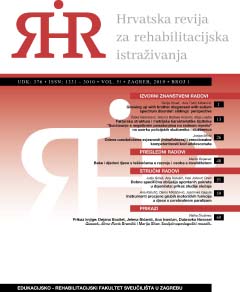DOBNO SPECIFIČNA OBILJEŽJA SPONTANIH POKRETA U DOJENČETA: PRIKAZ STUDIJE SLUČAJA
AGE-SPECIFIC CHARACTERISTICS OF GENERAL MOVEMENTS IN INFANTS: A CASE STUDY
Author(s): Julija Goleš, Ana Katušić, Ines Joković OrebSubject(s): Psychology, Health and medicine and law
Published by: Sveučilište u Zagrebu, Edukacijsko-rehabilitacijski fakultet
Keywords: general movements; writhing age; fidgety age; global and detailed general movement assessment;
Summary/Abstract: Insight into the normal function of the foetal brain is enabled by general movement assessment. Spontaneously generated movements are movements of the foetus and the young infant that manifest with age-specific characteristics at a writhing age andfidgety age. We distinguish normal repertoire and three types of abnormal general movements: poor, cramped-synchronised and chaotic general movements. Research has shown the best predictive strength for movements in the fidgety age, from 2 to 4 months of life. The main aim of the present study was to investigate the optimality and age-specific characteristics ofgeneral movements in toddlers at writhing and fidgety ages. The study participant was a male full-term newborn born at 40 gestational weeks from a healthy pregnancy without any risk factors. We performed global assessment ofgeneral movements, detailed assessment of the quality of general movements at the writhing age as well as measurements of the occurrence andfrequency of specific movements towards the midline at the fidgety age. The results show that the infant had a poor repertoire at writhing age that changed and appeared as a normal repertoire through the fidgety phase. Such a change in normality, between the transition in general movement patterns, occurs quite often in infants without risk factors and predicts normal neuromotoric outcome.
Journal: Hrvatska revija za rehabilitacijska istraživanja
- Issue Year: 55/2019
- Issue No: 1
- Page Range: 51-58
- Page Count: 8
- Language: Croatian

